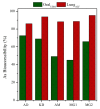Enhanced Gastric/Lung Arsenic Bioaccessibility from Lignite Fly Ashes: Comparing Bioaccessibility Rates with Multiple Environmental Matrices
- PMID: 37112585
- PMCID: PMC10143711
- DOI: 10.3390/toxics11040358
Enhanced Gastric/Lung Arsenic Bioaccessibility from Lignite Fly Ashes: Comparing Bioaccessibility Rates with Multiple Environmental Matrices
Abstract
Inorganic arsenic (As), a carcinogenic element to humans, is among the most dangerous and flammable substances that coal-burning plants could release. When coal is burned, large portions of arsenic are captured on fly-ash (FA) particles, but it could also contribute significantly to stack emissions of fine fly-ash particles. The aim of this study was to evaluate the oral and respiratory bioaccessibility of arsenic in lignite fly-ash (LFA) samples, and their contribution to total As exposure. Arsenic bioaccessibility fractions via ingestion and inhalation showed significant differences, suggesting the presence of highly soluble As-bearing phases in the studied LFA samples. The bioaccessible As fractions (BAF%) in the simulated gastric fluids (UBM protocol, ISO 17924:2018) showed a range of 45-73%, while the pulmonary bioaccessibility rates in the simulated lung fluid (artificial lung fluid (ALF)) exhibited significantly enhanced levels ranging from 86% to 95%. The obtained arsenic bioaccessibility rates were compared with previous data for multiple environmental matrices such as soil and dust-related materials, revealing that LFA exhibited significantly higher bioaccessibility (%) for the inhalation pathway.
Keywords: Greece; arsenic; bioaccessibility; gastric; lignite fly ash; mineralogy; respiratory.
Conflict of interest statement
The authors declare no conflict of interest.
Figures







Similar articles
-
In vitro assessment of oral and respiratory bioaccesibility of trace elements of environmental concern in Greek fly ashes: Assessing health risk via ingestion and inhalation.Sci Total Environ. 2020 Feb 20;704:135324. doi: 10.1016/j.scitotenv.2019.135324. Epub 2019 Nov 30. Sci Total Environ. 2020. PMID: 31837861
-
Enrichment and oral bioaccessibility of selected trace elements in fly ash-derived magnetic components.Environ Sci Pollut Res Int. 2017 Jan;24(3):2337-2349. doi: 10.1007/s11356-016-7967-4. Epub 2016 Nov 4. Environ Sci Pollut Res Int. 2017. PMID: 27815849
-
In vitro lung and gastrointestinal bioaccessibility of potentially toxic metals in Pb-contaminated alkaline urban soil: The role of particle size fractions.Ecotoxicol Environ Saf. 2020 Mar 1;190:110151. doi: 10.1016/j.ecoenv.2019.110151. Epub 2020 Jan 7. Ecotoxicol Environ Saf. 2020. PMID: 31923754
-
Arsenic relative bioavailability from diet and airborne exposures: Implications for risk assessment.Sci Total Environ. 2015 Dec 1;536:368-381. doi: 10.1016/j.scitotenv.2015.05.141. Epub 2015 Jul 28. Sci Total Environ. 2015. PMID: 26225742 Review.
-
Oral and inhalation bioaccessibility of potentially toxic elements in household dust from former Hg mining district, Idrija, Slovenia.Environ Geochem Health. 2021 Sep;43(9):3505-3531. doi: 10.1007/s10653-021-00835-z. Epub 2021 Feb 11. Environ Geochem Health. 2021. PMID: 33570697 Review.
References
-
- IARC (International Agency for Research on Cancer) Arsenic, Metals, Fibres, and Dusts. Monographs on the Evaluation of Carcinogenic Risks to Humans. A Review of Human Carcinogens. Volume 100 (C) IARC (International Agency for Research on Cancer); Lyon, France: 2012.
-
- Henke K. Arsenic: Environmental Chemistry, Health Threats and Waste Treatment. John Wiley & Sons Ltd.; Chichester, UK: 2009. pp. 69–235.
LinkOut - more resources
Full Text Sources
Research Materials
Miscellaneous

